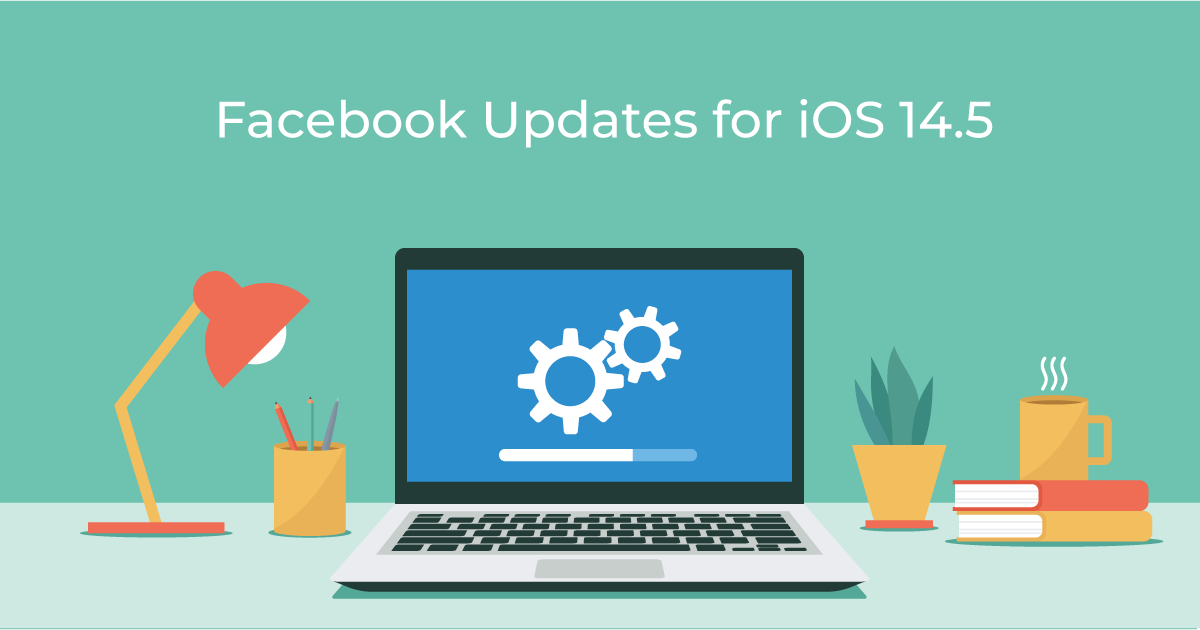A lot is happening in the paid advertising space. The cookieless future will affect paid advertising. And so will new privacy changes to iOS 14.5 and iPadOS 14.5 that roll out this week. Those changes are forcing Facebook to adapt and make its own updates for iOS 14.5 and Facebook Advertising.
In this post, I offer an overview of what advertisers can expect for advertising outside of apps along with actions they need to take for as smooth a transition as possible.
What’s Changing in iOS 14.5 and iPadOS 14.5?
In both the iOS 14.5 and iPadOS 14.5 releases, Apple introduces a typical array of updates and “new privacy controls” for websites and Privacy Click Measurement for apps. It’s these privacy measures that will affect paid advertisers on Facebook and Instagram around the globe.
Apple calls the controls, “Apple Tracking Transparency.” The controls enable users to decide whether or not to permit sites they visit to allow:
- Third-party apps and websites to track the user’s data
- Share the user’s data with data brokers who then sell the data to their clients
Much like with a cookie consent tool, where users are prompted to allow, manage, or reject cookies when visiting a site, iPhone and iPad users who install the new OSes will be prompted to allow or deny permission for third-party sites to track and/or share their data.
With iPhone users making up more than 45% of the smartphone market in 2020, and iPad users making up more than 36% of the tablet market in 2020, the new controls will affect paid advertisers’ ability to target users with relevant content and advertisements.
Users that opt-out of being tracked fall into a black hole where they can’t be served targeted ads based on their usage histories. They’re also be removed from any retargeting audiences they were included in before.
What Are the Facebook Updates for iOS 14.5 and iPadOS 14.5?
Facebook announced that it’s rolling out a new Aggregated Event Measurement model for Facebook Advertising following the launch of Apple’s new OSes. The change affects all Facebook advertising on all devices despite it being described as an update for iOS 14.5 and iPadOS 14.5.
Facebook reports that “Advertisers can expect to see changes in Facebook’s business and advertising tools set up, audience selection, delivery, measurement, and reporting.”
This change comes after previous changes where Facebook users on iOS and iPadOS were prompted to let Facebook track their activity in February. That prompt was Facebook’s way of getting ready for the new Apple OSes.
What Is Aggregated Event Measurement?
Aggregated Event Measurement, as described by Facebook, “is a protocol that allows for measurement of web events from iOS 14 users.” Stated differently, it’s a way for Facebook to model conversions likely made by users who’ve opted out of being tracked.
It functions somewhat like event management in Google Analytics 4. Events, such as purchase, add to cart, cart abandon, etc., will be tracked with a Facebook pixel installed on the advertiser’s domain.
What Advertisers Can Expect from Facebook’s Updates
Some time ago, Facebook moved away from 28-day click-through attribution windows. It now supports 7-day click-through and 1-day view-through attribution windows. This has already had an impact on Facebook advertising.
The new Aggregated Event Measurement will also have an impact.
Domains with permission to collect data from the new iOS users can track up to 8 conversion events for those users and use those events to optimize conversions. Because every audience includes some users with devices running iOS 14.5, the shift to using events isn’t just about iOS users, it affects everything and will likely become the new norm for Facebook advertising.
Impact on Audiences
Because users with a device running one of the new OSes can opt-out of being tracked, the size of available audiences in Facebook Advertising will be smaller.
That’s because users on iOS 14.5 devices that opt or opted-out of being tracked in the Apple prompt on Facebook or their devices will be excluded from Facebook Advertising’s Website Custom Audiences. That will reduce owned and retargeting audience sizes both in the short and long terms.
It’s not yet clear whether the Aggregated Event Measurement protocol of only attributing the highest priority event will affect audience retargeting. For example, if someone makes a purchase on your website, theoretically they’re still in your website visitors audience, your ATC audience, and your purchaser audience. It’s unclear if, with the Aggregated Event Measurement protocol, they will now only be in your purchasers’ audience.
Impacts on Measurement
Not only will advertisers be restricted to 8 events, attribution for Facebook advertising will become essentially a last-click model. And only events assigned the highest priority by an advertiser will be tracked as a conversion.
For example, say an advertiser’s highest priority event is a purchase. If a user clicks an ad, browses around, comes back, adds an item to the cart, and purchases, only the purchase event is counted toward/as the conversion and reported.
This means that advertisers will want to carefully prioritize the right events. If you want help creating a strategy, contact Finch.
Impacts on Reporting
The most noticeable impact of Facebook’s Updates for iOS 14.5 will be on reporting.
As mentioned, Facebook will limit conversion reporting to the highest priority event. It says that events that aren’t configured as one of the 8 available conversion events will be usable only in partial reporting and Custom Audience targeting.
The updates also limit reporting to one website domain for each Facebook pixel ad campaign. That means if you have different domains for different countries, you will need a different pixel for each domain.
And because some users are not being tracked, Facebook will model usage using an algorithm to essentially try and “fill the gap” for advertisers. What I think this will look like is that if Facebook tracks 5 actual conversions (users willing to be tracked) it will model how many other users (those not being tracked) likely converted as well.
Your end report will show the total modeled number. The models will use artificial intelligence to give advertisers as accurate a number as possible, but conversion tracking is likely to be less accurate than it was before the updates. Debugging conversions across channels will also be more challenging.
Impacts on Performance
As Facebook implements its updates for iOS 14.5 and iPadOS 14.5, advertisers should expect performance fluctuations, especially as user adoption of iOS 14.5 increases. There also will be an impact on delivery and reporting that results in performance fluctuations and increased cost per acquisition (CPA) until adoption is widespread.
Advertisers can prepare for fluctuating performance in the days and weeks following Facebook’s updates for the iOS changes. Because the changes will reduce the size and consistency of retargeting audiences, I recommend putting your focus on lookalikes audiences, owned data, and interest-based audiences during the transition.
Additional impacts are outlined by Facebook in its announcement.
What Advertisers Need to Do to Use Facebook’s Aggregated Event Measurement
Before advertisers can use the new web events — and even if they don’t want to use Aggregated Event Measurement — they need to make some changes. It’s not difficult, but it does require a few steps.
- Step one is to verify your domain with Facebook if needed.
- If you’re using an agency, such as Finch, to manage your social advertising, you also want to share your verified domain with your partner through Facebook Business Manager. Your agency or your Finch CSM can provide you with instructions.
- If you advertise in apps, you also want to update to Facebook SDK version 8.0 or higher.
- Next, implement the Conversions API on your pixel using the Settings or Implementations tabs within your pixel in Events Manager. This can be done using integrations built into the larger eCommerce platforms, such as Shopify, WooCommerce, etc., or with the help of a developer or web administrator.
You, your agency, and/or Finch will also need to:
- Pick which events you want to process with Aggregated Event Measurement. This is done at the ad set level.
- Create your conversion or value optimization campaign in Ads Manager; choose a pixel and conversion event for your campaign as well as a single domain.
- Review ads and ad sets that will be paused and update or replace them. This is done in the Resource Center tab in Facebook Ads Manager. Note that:
- Facebook will pause ad sets that aren’t optimized for an event configured for Aggregated Event Measurement.
- Facebook will pause ads that haven’t selected a domain for tracking.
Bottom Line
Aggregated Event Measurement is the future of Facebook advertising. Like any development in the online world, it won’t be a static development. Per Facebook, “Aggregated Event Measurement will continue to evolve with upcoming browser changes to help our advertisers support consumer privacy.”
Advertisers and the industry will continue to evolve too. I’m confident that Facebook will do everything it can to protect advertisers and the revenue it generates from advertisers.
Whatever happens, Finch will stay on top of developments. And advertisers that work with Finch and the Finch Advertising management Platform will continue to enjoy uninterrupted, accurate reporting pulled from Facebook Advertising reporting into Finch Insights reporting.
The best thing advertisers can do now is to make the necessary updates to their Facebook Advertising accounts outlined above and be prepared for some hiccups in the next few months as the new model takes shape.






